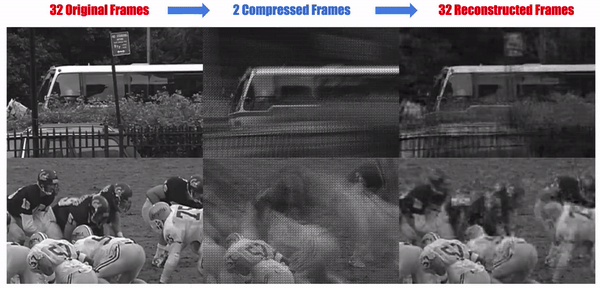Video compressive sensing aims at increasing the temporal resolution of a sensor by incorporating additional hardware components to the camera architecture and employing powerful computational techniques for high speed video reconstruction. The additional components operate at higher frame rates than the camera’s native temporal resolution giving rise to low frame rate multiplexed measurements (middle frames) which can later be decoded to extract the unknown observed high speed video sequence (right frames).
A deep learning framework for video compressive sensing [Paper] [Project Page]
Deep Fully-Connected Networks for Video Compressive Sensing Michael Iliadis*, Leonidas Spinoulas*, Aggelos K. Katsaggelos In Elsevier Digital Signal Processing, 2018. (* equal contributions)
- Linux or MacOS
- Python 3
- NVIDIA GPU + CUDA CuDNN
- Install PyTorch and dependencies from http://pytorch.org
Install all requirements below (with pip or conda)
- imageio (https://imageio.github.io/)
- h5py (http://www.h5py.org/)
- pandas (https://pandas.pydata.org/)
- bokeh (https://bokeh.pydata.org/en/latest/)
The repo has been tested on Ubuntu 18.04, Python 3.9.1, PyTorch 1.7.1 and CUDA 11.0
git clone https://github.com/miliadis/DeepVideoCS
cd DeepVideoCS- reconstructed_videos: All reconstructed videos from different algorithms
- paper_videos: 14 Videos that we tested in our paper
Put dataset folder under download folder
Put model under download folder
To reproduce paper's results please run the following script:
python test.py './download/papers_video' fcnet 7 './download/model_best.pth.tar' --save_videos='./output_videos' --gpu_id 0If you want to reproduce results with noise use the option 'noise'.
Here are all options:
usage: test.py [-h] [--block_opts BLOCK_OPTS [BLOCK_OPTS ...]]
[--block_overlap] [--noise NOISE] [--mean MEAN] [--std STD]
[--seed SEED] [--save_videos SAVE_VIDEOS]
[--save_format SAVE_FORMAT] [--gpu_id GPU_ID]
data arch layers_k pretrained_net
PyTorch Video Compressive Sensing - Testing
positional arguments:
data path to testing dataset
arch choose model name
layers_k number of FC layers in decoder
pretrained_net pre-trained model path
optional arguments:
-h, --help show this help message and exit
--block_opts BLOCK_OPTS [BLOCK_OPTS ...]
Item order: (temporal size, spatial size, video chunks)
--block_overlap overlapping blocks or not
--noise NOISE Noise Level in dB: e.g., 20, 30, 40
--mean MEAN Mean file
--std STD Standard deviation file
--seed SEED random seed
--save_videos SAVE_VIDEOS
path to save videos
--save_format SAVE_FORMAT
format for saving video file: avi, gif
--gpu_id GPU_ID choose gpu id
- train_data: 10 million video patches of size (8x8x16) - 41GB
- val_data: Video used for validation
Extract and put train and val data under download folder
To reproduce paper's results for FC7 network please run the following script:
python train.py './download/h5_data/' './download/ValVideos/' fcnet 7 --hdf5 --encoder_lr=0.0 --decoder_lr=0.01 --decoder_annual 0.1 400 --bernoulli_p=50 --save='10M_50_7_mask_non_trained' --epochs=600 --gpus 0If you want to reproduce results with noise use the option --noise=20.
Here are all options for training script:
usage: train.py [-h] [--hdf5] [--mean MEAN] [--std STD] [--workers WORKERS]
[--gpus GPUS [GPUS ...]] [--pretrained_net PRETRAINED_NET]
[--mask_path MASK_PATH] [--bernoulli_p BERNOULLI_P]
[--block_opts BLOCK_OPTS [BLOCK_OPTS ...]] [--block_overlap]
[--noise NOISE] [--seed SEED] [--epochs EPOCHS]
[--batch-size BATCH_SIZE] [--encoder_lr ENCODER_LR]
[--decoder_lr DECODER_LR]
[--encoder_annual ENCODER_ANNUAL [ENCODER_ANNUAL ...]]
[--decoder_annual DECODER_ANNUAL [DECODER_ANNUAL ...]]
[--gradient_clipping GRADIENT_CLIPPING] [--momentum MOMENTUM]
[--weight-decay WEIGHT_DECAY] [--start-epoch START_EPOCH]
[--print-freq PRINT_FREQ] [--results_dir RESULTS_DIR]
[--save SAVE] [--resume RESUME]
data_train data_val arch layers_k
PyTorch Video Compressive Sensing - Training
positional arguments:
data_train path to training dataset
data_val path to validation dataset
arch choose model name
layers_k number of FC layers in decoder
optional arguments:
-h, --help show this help message and exit
--hdf5
--mean MEAN Mean file
--std STD Standard deviation file
--workers WORKERS number of data loading workers (default: 0)
--gpus GPUS [GPUS ...] GPUs list: e.g., 0 1
--pretrained_net PRETRAINED_NET
pre-trained model path
--mask_path MASK_PATH
provide a pre-defined compressive sensing mask
--bernoulli_p BERNOULLI_P
percentage of 1s for creating mask
--block_opts BLOCK_OPTS [BLOCK_OPTS ...]
Item order: (temporal size, spatial size, video
chunks)
--block_overlap overlapping blocks or not
--noise NOISE Noise Level in dB: e.g., 20, 30, 40
--seed SEED random seed
--epochs EPOCHS number of total epochs to run
--batch-size BATCH_SIZE
mini-batch size (default: 200)
--encoder_lr ENCODER_LR
initial learning rate for encoder
--decoder_lr DECODER_LR
initial learning rate for decoder
--encoder_annual ENCODER_ANNUAL [ENCODER_ANNUAL ...]
Item order: (divide by, for every # epochs, until
epoch #, then lr=0)
--decoder_annual DECODER_ANNUAL [DECODER_ANNUAL ...]
Item order: (divide by, at epoch [#])
--gradient_clipping GRADIENT_CLIPPING
gradient clipping to prevent explosion
--momentum MOMENTUM momentum
--weight-decay WEIGHT_DECAY
weight decay (default: 0)
--start-epoch START_EPOCH
manual epoch number (useful on restarts)
--print-freq PRINT_FREQ
print frequency (default: 1000)
--results_dir RESULTS_DIR
results dir
--save SAVE folder to save checkpoints
--resume RESUME path to latest checkpoint (default: none)
If you use this code for your research, please cite our papers.
@article{DeepVideoCS2018,
title = "Deep fully-connected networks for video compressive sensing",
journal = "Digital Signal Processing",
volume = "72",
pages = "9 - 18",
year = "2018",
url = "http://www.sciencedirect.com/science/article/pii/S1051200417302130",
author = "Michael Iliadis and Leonidas Spinoulas and Aggelos K. Katsaggelos"}
Code is inspired by pytorch-imagenet-example, convnets-in-pytorch and cyclegan.
